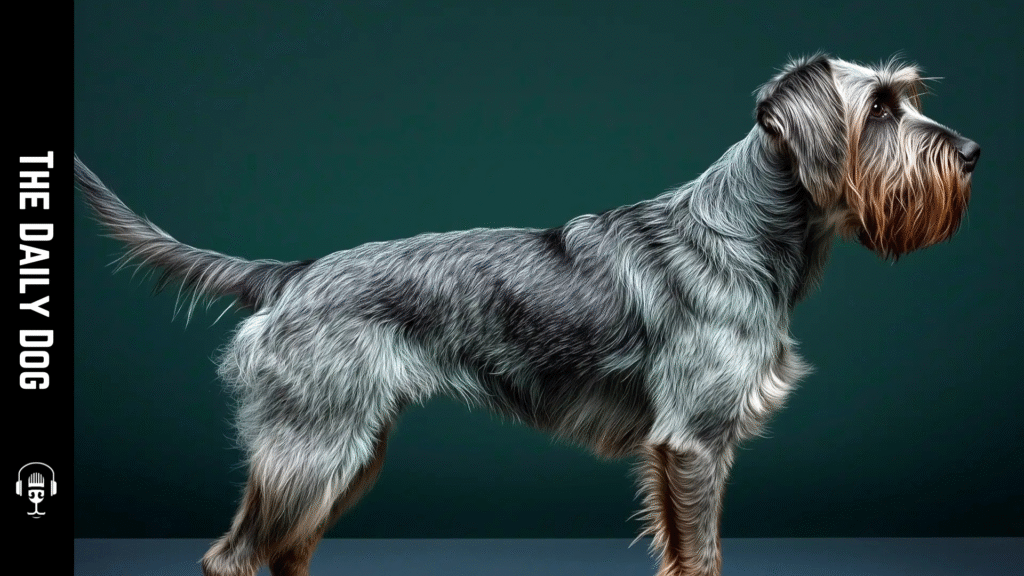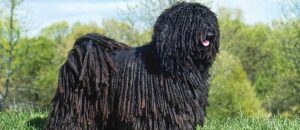In the landscape of traditional European gun dogs, the Griffon Nivernais stands out as a living link to rural France and the long history of scent-driven hunting. This robust, noble canine embodies stamina, courage, and a keen sense of purpose that has earned it a dedicated following among hunters, breeders, and dog lovers alike. If you’re seeking a devoted companion with a strong work ethic and a temperament that harmonizes with an active lifestyle, the Griffon Nivernais deserves a thoughtful look. This post explores the breed’s origins, personality, care requirements, and what it takes to welcome a Griffon Nivernais into a modern home.
Origins and profile: a breed forged in the heart of France
The Griffon Nivernais, sometimes referred to as the Nièvre Griffon, traces its roots to the Nièvre region in central France. Its development stems from the traditional work of local hunters who sought a scenting dog capable of tracking across varied terrain—forests, hedgerows, and open fields. The breed’s character reflects the rugged landscapes in which it evolved: resilient, relentless when on the scent, and steady in temperament when at home.
This is not a toy or an ornamental breed. The Griffon Nivernais is a working dog by design, built for endurance, not merely appearance. Its size and strength are matched by an instinct to explore and a disciplined approach to tasks. For the right owner, that balance, drive without recklessness, independence with family attachment, creates a dog that is both effective in the field and a steady, affectionate companion in the home.
Physical traits and presence
The Griffon Nivernais typically presents as a sturdy, medium-to-large breed with a strong, athletic frame. Its coat is dense and wiry, adapted to cooler, damp climates, and it often carries a noble, alert expression. Height and weight vary with gender and line, but many individuals fall into the range associated with large scent hounds: ample body length, a deep chest, and substantial bone structure that conveys power without bulk.
Coat maintenance is a consideration. The wiry coat requires regular brushing to remove dead hairs and prevent matting, particularly after outdoor excursions. Occasional hand-stripping or trimming may be recommended by breeders or grooming professionals to maintain a tidy appearance and to help the coat shed naturally seasonally.
Temperament: independence with affection
The Griffon Nivernais is renowned for a steady, even temperament. It tends to be weigh-tied to its family, forming strong bonds with household members, especially those who participate in its daily training and exercise routine. Because it is a scent hound with a strong prey drive, it benefits from early socialization and consistent, positive reinforcement-focused training. It learns quickly when engaged with clear goals and rewards, but its independent streak means it may compartmentalize tasks if the training lacks variety or meaningful challenge.
In a family setting, the Griffon Nivernais is typically affectionate and protective without being overbearing. It often displays a calm, patient demeanor indoors, waiting for directions or companionship rather than engaging in unprompted mischief. Of course, like any breed, personality can vary from dog to dog, influenced by genetics, upbringing, and the home environment.
Intelligence and training: a balance of will and guidance
Intelligence is a hallmark of the Griffon Nivernais, particularly in scent work and problem solving. Training should reflect its instinctual drives: scenting, tracking, and given tasks that require concentration and persistence. Positive reinforcement methods—treats, praise, and interactive play—work well with this breed. Because the dog may possess a degree of willpower and independence, training sessions should be short, frequent, and varied to maintain engagement.
Early socialization is essential. Expose the Griffon Nivernais to a range of people, environments, noises, and other pets to build confidence and reduce the possibility of behavior issues stemming from fear or over-stimulation. Consistent boundaries and predictable routines help a dog of this lineage thrive in home life while still honoring its natural instinct to explore and seek out scents.
Exercise, stamina, and mental engagement
A Griffon Nivernais is not a couch potato by any measure. Its hunting heritage manifests as high endurance and a desire to work. Daily exercise is a necessity, not a luxury. Expect long walks, vigorous play, and opportunities for scent-based activities that challenge the dog’s nose and brain. If you enjoy activities like tracking games, scent puzzles, or field trials, the Griffon Nivernais can excel and stay motivated, provided workouts are appropriately scaled and timed to the dog’s age and fitness level.
Genuine physical activity should be balanced with mental stimulation. Without mental engagement, even a physically fit Griffon Nivernais can become bored or restless. Rotate training tasks, introduce new scent trails, and consider structured sniffing games that tap into its natural talents. For families with children, supervision and taught boundaries ensure the relationship remains safe and positive for everyone involved.
Grooming and care essentials
Grooming a Griffon Nivernais is straightforward but not optional. Regular brushing helps reduce shedding and keeps the wiry coat in good condition. Owners may choose to have the coat hand-stripped or trimmed periodically, depending on climate, coat growth, and personal preference. Bathing should be as needed, typically not frequent, using a dog-specific shampoo that preserves natural oils in the coat and skin.
Ear care is another important aspect. The breed’s drooping ears can be susceptible to moisture and debris, so routine ear checks and cleaning help prevent infections. Dental care, nail trimming, and general health checks should be part of a consistent routine that reinforces a healthy lifestyle and strengthens the bond between dog and owner.
Diet and weight management
A Griffon Nivernais thrives on a balanced diet that matches its activity level. Whether you choose premium commercial diets or a well-planned home-prepared menu, ensure the formula meets age, size, and energy requirements. Keep portions appropriate to avoid excess weight, which can place extra strain on joints and hinder the dog’s agility. Hydration is essential, especially after a long day of exercise or scent work.
Health considerations: staying ahead of common issues
As with any breed, the Griffon Nivernais has potential health concerns to monitor. Responsible owners should engage with a veterinarian to establish a proactive health plan tailored to the dog’s needs. Common areas of focus include:
- Hip and elbow health: Given the breed’s size and athletic demands, hip and elbow dysplasia can be concerns. Regular exercise, weight management, and joint-supportive strategies can help reduce risk and promote mobility.
- Skin and coat health: The wiry coat is resilient, but occasional skin irritations or allergies can arise. Regular grooming and prompt veterinary attention for any persistent itching, redness, or irritation are advisable.
- Ear care: Drooping ears require routine cleaning to prevent infections. If you notice repeated scratching, head shaking, odor, or discharge, seek veterinary advice.
- Eye protection: Bright, keen eyes are a hallmark of scent hounds. Monitor for signs of irritation or redness and seek care if vision seems affected.
If you adopt a Griffon Nivernais, establish a relationship with a veterinarian who understands the breed’s traits and can tailor preventive care to your dog’s age, activity, and health history.
Choosing a Griffon Nivernais for your home
Bringing a Griffon Nivernais into your life is a decision that echoes the breed’s historical role as a working dog and a loyal family companion. The following considerations can help ensure a harmonious match:
- Lifestyle alignment: The Griffon Nivernais thrives with regular, structured activity. If your days are unpredictable or you prefer a low-energy home life, additional planning and adjustments may be necessary to meet the dog’s needs.
- Space and environment: While not requiring endless space, the breed benefits from access to safe outdoor areas for roaming, sniffing, and play. A secure yard or nearby parks can satisfy its exploratory instincts.
- Training commitment: Consistent, positive training is essential. Owners who can dedicate time to daily sessions, scent-related exercises, and ongoing socialization tend to see the best outcomes.
- Experience level: The Griffon Nivernais is best suited to owners with some experience in handling strong, confident, work-oriented dogs. Patience, clarity in communication, and a calm leadership style contribute to a successful partnership.
- Family integration: This breed generally does well in families that can provide routine, companionship, and boundaries. Proper socialization ensures the dog interacts safely and happily with children and other pets.
A note on adoption and breeders
If you’re considering adding a Griffon Nivernais to your family, you have two primary paths: adoption from a rescue or purchase from a reputable breeder. Rescues often have dogs of varying ages and backgrounds, offering a chance to provide a second home to a dog in need. When seeking a breeder, prioritize those who emphasize health testing, responsible breeding practices, and socialized puppies. Ask about genetic screenings, hip and elbow evaluations, and the breed’s standard references. A reputable breeder will welcome questions and provide clear guidance about temperament, care, and training expectations for your future canine companion.
Training milestones and practical tips
With a Griffon Nivernais, a structured orientation to training years starts early and continues throughout life. Here are practical milestones and tips to keep progress steady and positive:
- Puppy stage (8-16 weeks): Socialization, basic obedience, and gentle exposure to different habitats. Short sessions with high-value rewards work best for attention retention.
- Adolescent phase (6-12 months): Introduce more complex tasks, impulse control drills, and consistent boundaries. Maintain engagement with scent games that channel curiosity constructively.
- Adult years: Maintain routine exercise and mental challenges. Integrate scent work, trail exploration, and occasional formal training to prevent boredom.
- Senior years: Adapt activities to preserve mobility and comfort. Focus on targeted cognition games and low-impact physical activity to maintain quality of life.
Impactful companionship: the Griffon Nivernais in daily life
For families and individuals who prize resilience, loyalty, and a propensity for purposeful work, the Griffon Nivernais offers a compelling partnership. Its presence is more than physical; it’s an invitation to a shared journey of exploration, training, and genuine companionship. In return for honest care, consistent activity, and thoughtful leadership, the breed rewards you with a steady temperament, unwavering dedication, and a presence that elevates everyday life.
In the home, expect a dog that is attentive, frequently calm, and keenly aware of the household mood. Outside, you gain a loyal partner for long hikes, forests, and countryside adventures, an animal that approaches the day with purpose and a nose for discovering what lies beyond the next hedge.
Final reflections: why the Griffon Nivernais endures
The Griffon Nivernais endures because it embodies a timeless fusion of utility and affection. It is a dog bred for endurance and tenacity, capable of long, demanding hunts and equally capable of sharing peaceful evenings with a family. Its history informs a temperament that is both resilient and endearing, making it a remarkable choice for the right owner, someone who values tradition, is prepared for rigorous training, and appreciates the thoughtful, patient companionship that a scent hound can provide.
If you’re considering adding a Griffon Nivernais to your life, take stock of your daily rhythms and future plans. Confirm that you can deliver the balance this breed thrives on: demanding activity paired with devoted, affectionate interaction. With the right environment, the Griffon Nivernais becomes more than a striking presence at your side; it becomes a partner in discovery, a guardian of home, and a steadfast contributor to the shared life you build together.
In sum, the Griffon Nivernais is a lineage with purpose, an elegant, formidable, and deeply loyal dog that carries forward a heritage of scent work and rural resilience. For the right owner, it is not merely a pet but a lifelong collaborator: a dog whose eyes reflect the patience of the countryside, whose steps echo the cadence of the hunt, and whose heart remains firmly anchored in the family it cherishes.










